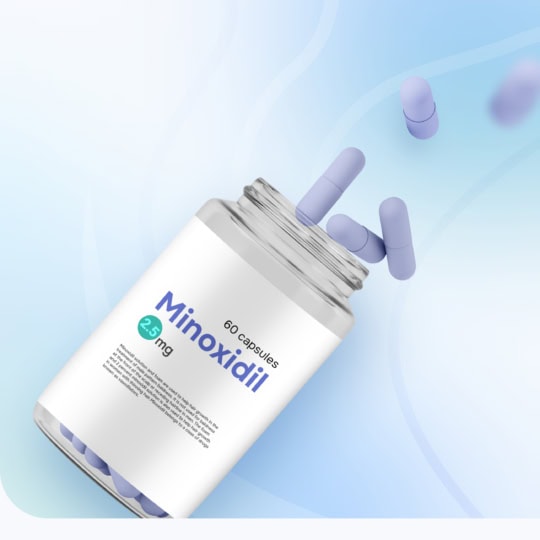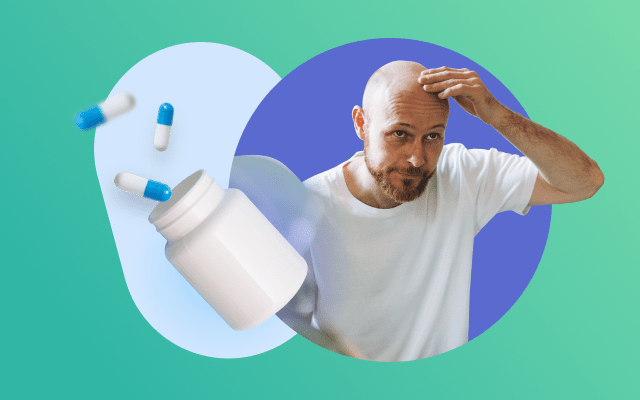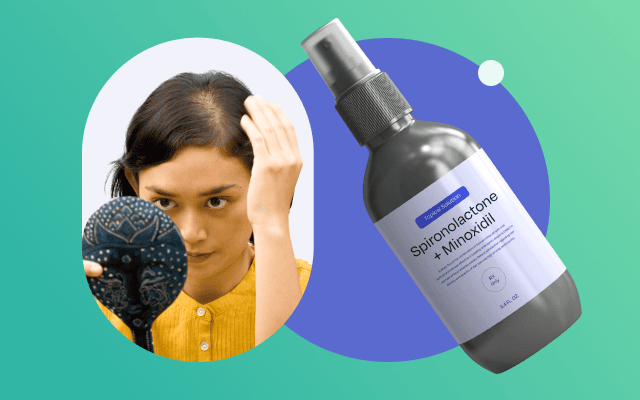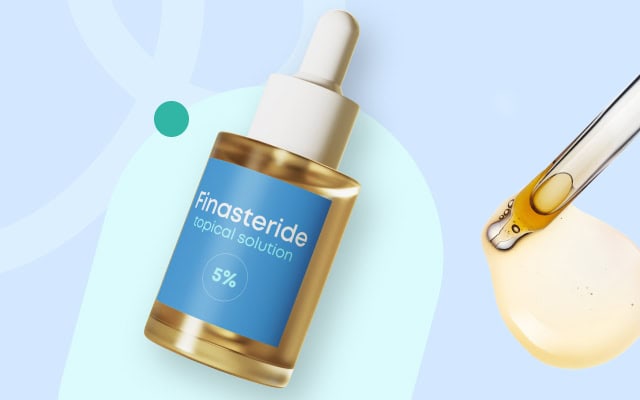How much oral minoxidil should you take daily?
Oral minoxidil is widely used for non-scarring hair loss by dermatologists because it’s effective. This guide for patients by Dr. Om, board-certified dermatologist, answers common questions about its use for hair loss.
Table of Content:
What is minoxidil? | Why take oral minoxidil for hair loss? | When to see a dermatologist for hair loss? | How to get an oral minoxidil prescription online? | Recommended dose for men | Recommended dose for women | How long does oral minoxidil take to work? | Side effects | Who should avoid it? | FAQ
Our commitment to producing high-quality content:
The information presented in this article is based on scientific research and the professional advice of our Content Medical Reviewers, who are experts in the field of Dermatology. How we write our content →
Last updated November 2025.
Dr. Amit Om, board-certified dermatologist, says that oral minoxidil is an increasingly popular prescription option for treating hair loss in both men and women. Originally developed to manage high blood pressure, it is now prescribed off-label in low doses to stimulate hair growth, particularly when topical minoxidil does not deliver results.
In this guide, Dr. Om explains:
- The recommended oral minoxidil dosages for men and women
- How long it takes to work
- Common side effects and safety tips
- How to get an oral minoxidil prescription online through Miiskin
What is oral minoxidil?
Dr. Om, says that oral minoxidil is a tablet form of the same medication found in topical minoxidil (Rogaine®). While the topical solution is applied directly to the scalp, the oral version is taken once daily and works systemically to stimulate hair follicles.
In some cases, dermatologists prescribe it off-label to treat:
- Male pattern hair loss (androgenetic alopecia)
- Female pattern hair loss
- Chronic telogen effluvium
- Alopecia areata
Dr. Om says that compared to topical forms, oral minoxidil can be more convenient and effective for some patients, especially those who experience scalp irritation or find it difficult to apply liquid or foam daily.
Learn more: Oral vs topical minoxidil – which works better?
Why take oral minoxidil for hair loss?
Dr. Om explains why oral minoxidil is becoming so popular among dermatologists and patients:
- Combination therapy: oral minoxidil may be used in combination with other treatments, potentially enhancing the effectiveness of a hair loss treatment regimen.
- Affordable: Minoxidil tablets are about $1 per tablet, which is less expensive than topical formulations, especially when considering the long-term use.
- Effective: Studies suggest that oral minoxidil is at least as effective than topical minoxidil in promoting hair growth.
- Uniform hair growth: Oral administration ensures better absorption and since it is systemically absorbed, it promotes a much more even hair growth.
- Convenient: Taking a tablet is often easier and less messy than applying a topical solution evenly throughout the entire head.
When to see a dermatologist for hair loss?
Dr. Om says that if you have tried topical minoxidil without success or want a more convenient treatment, it may be a good idea to consult an online dermatologist via Miiskin.
The dermatologists in the Miiskin network can:
- Assess your hair loss type
- Prescribe the right oral minoxidil dose (or alternate medication, if not suitable for you)
- Provide medication refill visits and follow-up support to monitor results
How to get an oral minoxidil prescription online?
Dr. Om explains that oral minoxidil is prescription-only and should be taken under medical guidance. With Miiskin, you can get a prescription with a dermatologist in approximately 24 hours, without leaving home.
Here’s how getting an online prescription works
- Complete a short online consultation with details about your hair loss. First time consultation is $59 and medication renewals are only $39. Wait 1-2 days to get a response.
- A board-certified dermatologist reviews your case and prescribes oral minoxidil if suitable. If it is not suitable for your hair loss, you will still get a treatment plan that is safe and adequate for you.
- You buy your medication at a local or online pharmacy and the medication is delivered to your door through the partnered pharmacy.
Recommended oral minoxidil dose for hair loss
Dr. Om says that there is no one-size-fits-all dose. Your online dermatologist will determine the right amount based on your gender, health profile, and how you respond to treatment. He also added that you should never adjust your dose without speaking to your dermatologist.
Recommended oral minoxidil dose for men
- Typical starting dose: 1.25 mg daily
- Maintenance dose: 2.5–5 mg daily
- The dose may be gradually increased under medical supervision for optimal results.
Recommended oral minoxidil dose for women
- Typical starting dose: 0.625–1.25 mg once daily (¼–½ of a 2.5 mg tablet)
- Maintenance dose: up to 2.5 mg daily
- Lower doses are usually recommended to minimize unwanted facial or body hair growth.
How long does oral minoxidil take to work?
Dr. Om says patience is key with hair growth treatments. Most people start to see visible improvements after 3–6 months of consistent use.
| Timeframe | What to expect |
| 0–2 months | Mild shedding phase (normal part of regrowth cycle) |
| 3–4 months | Reduced shedding; early fine regrowth |
| 6+ months | Noticeable thickening and improved density |
Shedding in the first few weeks is a sign the medication is working, as it resets your hair growth cycle.
Common side effects of oral minoxidil
Dr. Om explains that while low-dose oral minoxidil is generally well tolerated, side effects can occur. These are usually mild and dose-dependent. If you experience any severe side effects, stop the medication and contact your dermatologist.
Possible side effects
- Mild swelling in hands, feet, or face
- Temporary shedding (telogen effluvium)
- Increased hair growth in other areas (arms, face)
- Dizziness or lightheadedness (from lower blood pressure)
Rare side effects
- Rapid heartbeat (tachycardia)
- Fluid retention
- Headache
Who should avoid oral minoxidil?
According to Dr. Om, oral minoxidil is not suitable for everyone. You should avoid it or talk to your dermatologist if you:
- Are pregnant or breastfeeding
- Have a history of heart, kidney, or liver disease
- Have low blood pressure or are taking antihypertensive medication
- Are allergic to minoxidil
Lee éste artículo en Espanol ¿Qué es y para que sirve el minoxidil?
Article References:
https://www.ncbi.nlm.nih.gov/pmc/articles/PMC6691938
https://www.ncbi.nlm.nih.gov/pmc/articles/PMC9650732/
https://www.sciencedirect.com/science/article/abs/pii/S0190962221004187
https://www.ncbi.nlm.nih.gov/books/NBK430924/
https://pubmed.ncbi.nlm.nih.gov/35244759/
https://pubmed.ncbi.nlm.nih.gov/3674909/
https://www.medscape.com/viewarticle/986017
https://www.jaad.org/article/S0190-9622(23)00278-5/fulltext
https://www.ncbi.nlm.nih.gov/pmc/articles/PMC4887583/#
https://academic.oup.com/bjd/article-abstract/184/5/977/6702293
https://www.jaad.org/article/S0190-9622(19)32666-0/fulltext
https://pubmed.ncbi.nlm.nih.gov/9008235/
https://www.sciencedirect.com/topics/neuroscience/sympathomimetic-amines
https://www.drugs.com/drug-interactions/cortisone-with-minoxidil-748-0-1638-0.html#
https://karger.com/sad/article/6/3/175/304677/Low-Dose-Oral-Minoxidil-for-Female-Pattern-Hair
https://pubmed.ncbi.nlm.nih.gov/29231239/
https://pubmed.ncbi.nlm.nih.gov/17222303/
https://www.ncbi.nlm.nih.gov/books/NBK554421
https://www.ncbi.nlm.nih.gov/books/NBK513329/
https://onlinelibrary.wiley.com/doi/abs/10.1111/dth.12246
Hair loss articles
Reviewed by dermatologists
Using oral minoxidil at a low dose for hair loss
Is alopecia genetic or hereditary?
How to stop alopecia areata from spreading?
Does creatine cause hair loss?
Which vitamin deficiency ACTUALLY causes hair loss?
Can I use a derma roller with minoxidil for enhanced hair growth?






 Request an oral minoxidil prescription for hair growth!
Request an oral minoxidil prescription for hair growth!